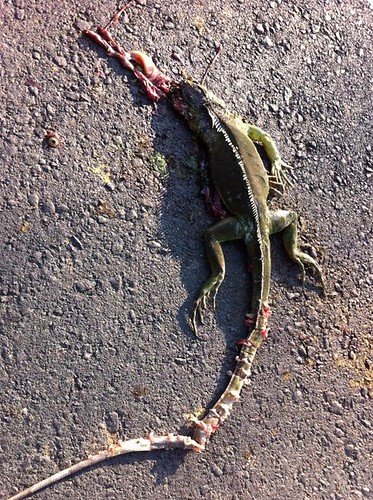
Green iguanas are native to Central and South America. It is saddening and shocking to sight such exotic wildlife here in Singapore, smuggled in to meet the demand for reptiles as illegal pets. This poor adult male Iguana was found run over and dead on the roads on Sungei Tengah road, right in our neighbourhood - Another victim of the illegal wildlife trade being abandoned to fend for himself.In recent decades, green iguanas (Iguana iguana) have managed to spread beyond their native range, and establish breeding populations in places such as Puerto Rico, Texas, Hawaii, and especially in Florida, causing concern among residents. The descendants of iguanas that escaped from captivity or were released abandoned by owners, it appears that at least in Florida, completely eradicating them is no longer an option, and that they are here to stay. With the balmy subtropical climate (barring the occasional cold snap) and plenty of greenery to munch on, Green Iguanas are able to thrive all year round, with unknown impacts on native vegetation and wildlife. Some people are exploring the idea of harvesting green iguanas for meat as a means of population control.
Here in Singapore, the only reptiles allowed as pets are the red-eared slider (Trachemys scripta elegans) and Malayan box turtle (Cuora amboinensis). Hence, anyone seen selling, buying, or possessing a green iguana without a permit most certainly obtained it through illegal means. Like a number of other exotic species, green iguanas have been encountered in the wild, and while there are no signs to suggest that they're breeding here, one does wonder about the potential threats to our parks and forests posed by a large herbivorous lizard.
Among the recent sightings of green iguana include one seen in the Japanese Gardens at Jurong Lake last year. Another was found in a residential neighbourhood in Bishan in 2008, and was most likely dumped by someone.


Green iguana harassing Malayan water monitor at Sungei Buloh, 2005;
(Photos by Chua Eng Kiat)
Worryingly enough, a male green iguana was spotted from time to time at Sungei Buloh, where he was once seen behaving aggressively towards the larger resident Malayan water monitors (Varanus salvator), driving them away from a prime basking spot. I'm not sure if he's still around though.



Green iguana at Sungei Buloh, 2005;
(Photos by Con Foley)
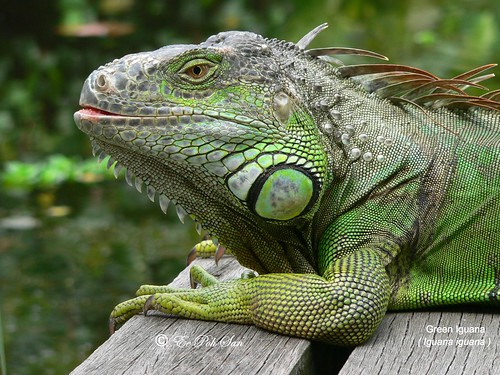
Green iguana at Sungei Buloh, 2008;
(Photo by Ee Poh San)
Other green iguanas found in the wild are rescued by the ACRES Wildlife Rescue Team. Some of these carry a slew of health issues, showing a lack of proper care at the hands of people ill-prepared for the commitment and resources involved in the upkeep of such large reptiles, or the trauma of suddenly being forced to fend for themselves in an unfamiliar environment. Given endearing (often fitting) nicknames, each iguana has its own story to tell.
Midori

(Photo by Anbarasi Boopal)
Midori was discovered roaming around an industrial estate in Singapore- a long way from the South American forests where he belongs. Unable to find proper food for a long time, Midori was dehydrated, thin and covered with sores and mouth ulcers when we rescued him. It became evident that he'd been forced to raid trash bins for food when he excreted a razor blade in his faeces soon after his rescue. Midori remained in critical care receiving special treatment for many weeks and didn't want to eat for a long time, probably because his mouth ulcers made eating so painful.Valerie
Whilst he was recovering, our Animal Caregivers set to work making Midori's new home as comfortable as possible for him, fixing up lots of furniture for him to climb and platforms to rest on, branches to rub himself on, water to soak in and plenty of nice warm sunny spots for him to bask in! Today, as well as enjoying his new surroundings, Midori enjoys feasting on fresh vegetables and fruits and pulling the flowers from the fresh twigs we give him daily before chomping them down. Midori is a feisty character- wild through and through- and we hope he can return to the wild one day.


(Photos from ACRES)
Valerie the Green iguana is, like all of the non-native residents at the ACRES Wildlife Rescue Centre (AWRC), a victim of the illegal exotic pet trade in Singapore. Like many other wild animals who are illegally kept as pets in Singapore, Valerie was cruelly abandoned by a careless owner. A member of public found her and a box was handed over to us, mentioning there is a huge monitor lizard inside. To our surprise, a severely stressed green iguana appeared!Frankie
Her black colouration showed how much pain she has gone through. And like so many others before her, help arrived just in time for Valerie to save her from certain death from serious health problems Having moved into a bigger enclosure with hiding spaces to feel safe, she is slowly turning colourful and showing interest in food and the environment. Our care-givers still worry about her and we hope that her health will improve soon!

(Photo from ACRES)
Just rescued Frankie, the green iguana who was found abandoned here in Singapore. He is native to Central and South America and is another victim of the illegal reptile trade. Thanks to the member of public who called ACRES in time. Sadly, Frankie has a deformed lower jaw and severe mouth ulcerations. He is currently under observation and critical care at the AWRC (ACRES Wildlife Rescue Centre).Scratch




(Photos from ACRES)
Scratch is yet another victim of the illegal wildlife trade in Singapore. Probably abandoned by someone, a mamber of public found him at a nursery in Choa Chu Kang area, and called ACRES. Scratch does not like being handled, a clear indication that these animals do not make suitable pets and likes to leave a signature scratch on our care givers. He is currently under observation.Tentententen

(Photo from ACRES)
Here's a photo of Tentententen (the rescue story we posted about 2 weeks ago), a new resident to the ACRES Wildlife Rescue Centre. Tenx4 is yet another victim of the illegal reptile pet trade in Singapore, dumped into the wild by his owner possibly recently. We are relieved he did not end up like Frankie and other animals who were found too late. Stay tuned for some photos of him enjoying his new home. He was named as such because he was found on 10/10/10 at 10pm.Green Iguanas are also featured in several local captive animal collections, including the Singapore Zoo, Jurong Bird Park, and Sentosa's Butterfly Park & Insect Kingdom. Kept in large walk-in aviaries and other enclosures meant to simulate a rainforest habitat, complete with artificial waterfalls and colourful tropical birds, these reptiles lend an extra dash of the exotic without jeopardising the other captive animals or the safety of the visitors; most other large lizards like monitors (Varanus spp.) or tegus (Tupinambis spp.) would end up preying on the other inhabitants.
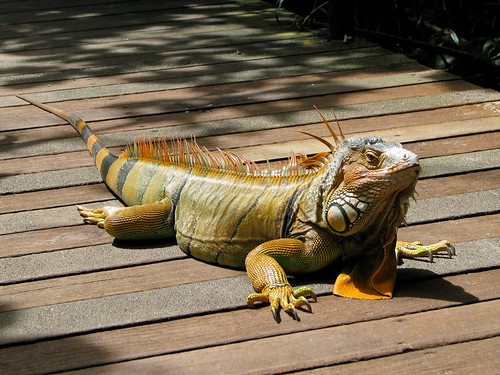
Green iguana at the Singapore Zoo;
(Photo by Agnieszka Wetton)
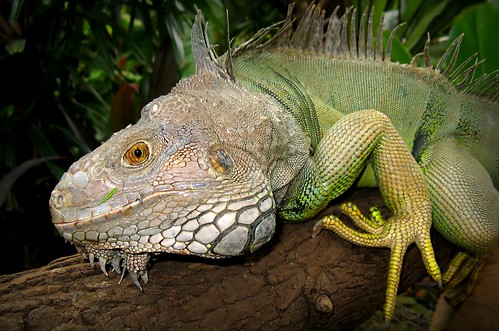
Green iguana at the Butterfly Park & Insect Kingdom;
(Photo by Sue323 :-))
However, it is likely that escapes (or even thefts) do occur, and at the Jurong Bird Park at least, there are now free-ranging green iguanas. I myself saw one mingling with the flamingos and ibis at the Flamingo Lake last December.

This green iguana at the Jurong Bird Park was apparently not inside any of the enclosures or exhibits;
(Photo by MKBirder)
I wonder if there is the possibility that some of the sightings of 'wild' Green Iguanas in Singapore involved escapees from these zoological collections.
Besides the Green Iguana, a number of other non-native reptiles have also been recorded as victims of motor vehicles.

(Photo by ACRES)
For instance, this female wattle-necked softshell turtle (Palea steindachneri), was run over near the Singapore Botanic Gardens. Despite emergency care by ACRES Wildlife Rescue, she succumbed to her injuries. This species hails from China and Vietnam, and is highly exploited for food; as a result, it is endangered in the wild, although non-native populations on Hawaii are thriving.

(Photo by ACRES)
This red-eared slider in Kranji had clearly been run over multiple times. This native of the southern United States of America is the turtle most often seen in the pet trade, and consequently, due to people releasing and dumping their pets when they're no longer wanted, is the most commonly seen turtle in many of our ponds, reservoirs, and canals.
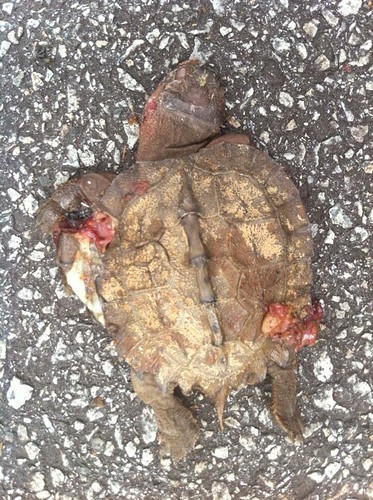
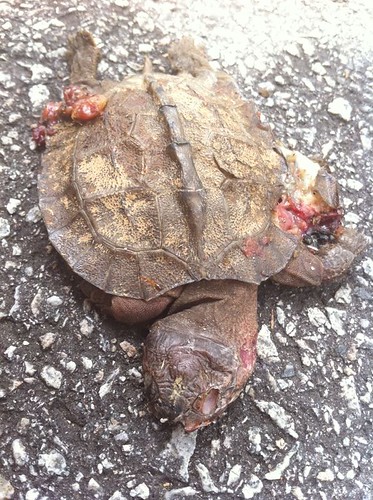

(Photo by Fung Tze Kwan)
Another non-native turtle species, albeit one that's found closer to home in Indochina and northern Peninsular Malaysia, this giant Asian pond turtle (Heosemys grandis) still had lots of growing to do, when it was run over near Upper Seletar Reservoir. Given that this was found on the morning of Vesak Day, there is the possibility that it had been dumped by people seeking to gain good karma by liberating animals (while oblivious to the possible ecological damage or cruelty). On the other hand, it may mean that this species has started breeding here; all previous local records are of large adults.

(Photo by Vilma D'Rozario)
An interesting record comes from this roadkilled rainbow mud snake (Enhydris enhydris), also seen in Kranji. This provides confirmation that this species, already widespread throughout much of Southeast Asia, does exist in Singapore, although whether it is a native or was accidentally introduced remains a point of contention.
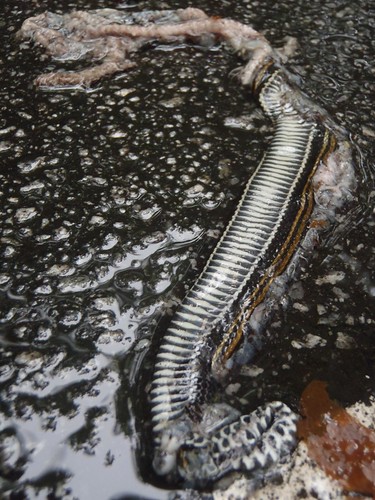
(Photo by Jocelyne Sze)
Native to Java, Bangka, and Sumatra, the striped keelback (Xenochrophis vittatus) is considered locally common, and is one of the few confirmed non-native snake species in Singapore. This particular roadkilled individual was seen in Punggol.

(Photo by Fung Tze Kwan)
The changeable lizard (Calotes versicolor) is the classic example of a non-native reptile in Singapore, having practically taken over most terrestrial habitats found throughout the country, from bushes planted along urban roads, to secondary woodland and scrub in rural areas. These are usually quick enough to avoid vehicles, but once in a while, one makes a fatal mistake. Another highly successful and widespread species that is found across much of Southern and Southeast Asia, it is likely that it represents a species complex of several closely-related but distinct forms.
We have fewer non-native amphibian species in Singapore, although one suspected non-native is now one of the most common frog species in Singapore; I remembered once coming across an oddly-coloured patch on a road in Pasir Ris that on closer inspection, turned out to be a truly flattened banded bullfrog (Kaloula pulchra), ground into the tarmac by the wheels of countless cars.
One particular incident involving roadkill stands out, because I witnessed it happening.
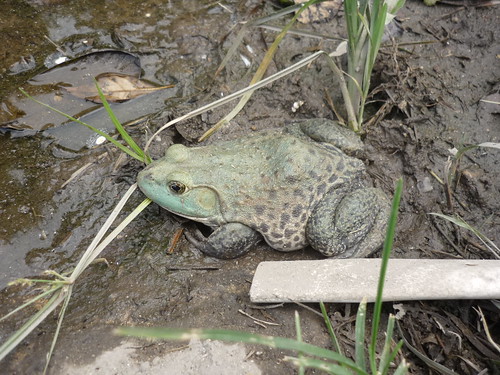
I had just visited a farm in Kranji that raised American bullfrogs (Lithobates catesbeianus) and various freshwater fishes for food. As I was walking out of the gate, I saw this frog by the roadside, having obviously escaped. The bullfrogs were confined to high-walled concrete enclosures, although I'm sure that a frog might occasionally make a leap so exceptional that it manages to clear the barrier. It's also possible that the bullfrogs had already managed to colonise the large earthen ponds used for raising fish.
In any case, the bullfrog started leaping across the road, and in fact, almost made it to the other side. Many cars simply passed over it, but one eventually struck the frog with a loud pop.

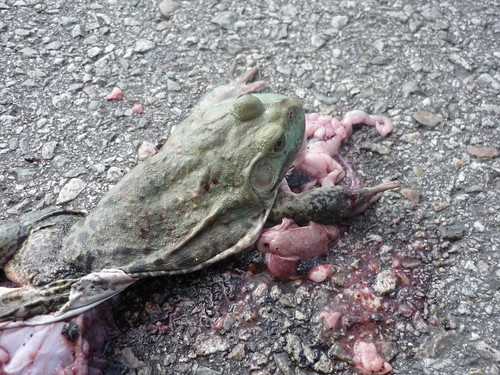

The results weren't pretty. I tried to take whatever photos I could, while moving out of the way of approaching vehicles.
It's a nasty way to go, but knowing the potential for ecological disaster should American bullfrogs become established in our freshwater habitats, I was feeling quite conflicted. Should I be relieved that at least there was one less American bullfrog managing to escape into the wild and contributing to the feral population? Or should I have felt sad over the tragic loss of life, regardless of whether it was a native species or undesirable invasive; perhaps the least I could have done was to chase it back into the farm compound.
I am appreciative of the fact that drivers (and their cars) inadvertently contribute to Monday Morgue by creating entries for submission. Still, I always get a shudder when I think about how the animal must have felt, the moment its life was snuffed out beneath the tyres of a car, with the driver most probably oblivious or completely ignorant of the carnage.
Roads can provide avenues for invasion, creating trails for opportunistic species, often non-natives, to colonise new areas, and make inroads into often otherwise pristine habitats. However, in the case of this American bullfrog, and the green iguana that started off this post, they paid the price for being in the wrong place at the wrong time.
Next up: in my final post, I'll share some examples of native wildlife clearly affected by roads and the habits of drivers, and how we can contribute to efforts, whether it's in rescuing animals wounded by cars, documenting roadkill and providing vital information on species diversity and population dynamics, or supporting projects to create wildlife corridors, enabling animals to cross roads without the risk of getting run over.
(Cross-posted to Monday Morgue)